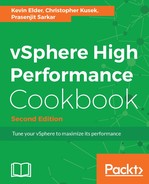Load-based teaming, also known as Route based on physical NIC load, maps vNICs to pNICs and remaps the vNIC to pNIC affiliation if the load exceeds specific thresholds on a pNIC. LBT uses the originating port ID's load balancing algorithm for the initial port assignment, which results in the first vNIC being affiliated to the first pNIC, the second vNIC to the second pNIC, and so on. Once the initial placement is over after the VM is powered on, LBT will examine both the inbound and outbound traffic on each of the pNICs and then distribute the load across if there is congestion.

LBT will send a congestion alert when the average utilization of a pNIC is 75 percent over a period of 30 seconds. The 30-second interval is used to avoid MAC flapping issues. However, you should enable PortFast on the upstream switches if you plan to use STP. VMware recommends LBT over IP hash when you use, vSphere Distributed Switch, as it does not require any special or additional settings in the upstream switch layer. In this way, you can reduce unnecessary operational complexity. LBT maps vNIC to pNIC and then distributes the load across all the available uplinks, unlike IP hash which just maps the vNIC to pNIC but does not do load distribution. LBT reduces the chance of pNIC imbalance compared to IP hash.
